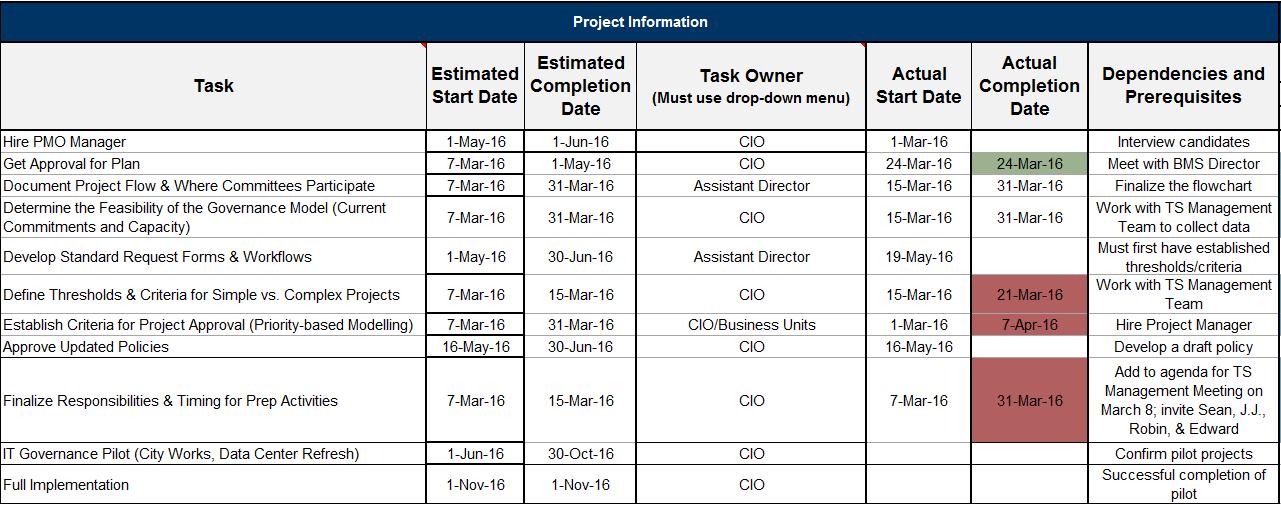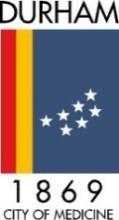

IT Governance
City of Durham, NC June 13, 2016


Goal




Governance fosters Innovation and High Performance
Core benefits of IT governance are seen through:
Value creation

Increases the speed of decision-making and alignment with business priorities.
Operating cost reduction

Limits duplication of effort, and ensures meetings are effective by setting appropriate meeting goals and participation.
Risk optimization

Increases regulatory compliance, and ensures the appropriate processes are in place and monitored to mitigate risk issues.
IT governance is difficult to structure appropriately, but having an effective structure will allow the City of Durham to:
Clarify decision-making accountabilities and provide a formalized process for managing organizational decision making.
Save time and money – by optimizing the responsibilities and participation on IT governance committees.
Improve transparency of IT costs.
Foster a culture of accountability for decision making, identifying and resolving issues, and open communication throughout the organization.
Ensure processes are in place and followed around the prioritization and management of projects, changes, and services.
Optimize the City’s resourcing by ensuring that priority initiatives, services, and projects are provided adequate staffing through defined, documented, and communicated roles and responsibilities.


Separate IT Governance from IT Management
It’s important not to blur the lines between governance and management; each has their unique role to play. Confusing these means wasted time and confusion around ownership.
Governance
IT Governance sets direction through prioritization and decision making, and monitors overall IT performance.
Governance sets the vision and policies for the organization.
An IT Governance committee decides which projects IT undertakes, including resource allocation and investment. The governance committee reviews the success metrics of the project.
Management
Management is responsible for executing on, running, and monitoring activities as determined by IT governance.
Management makes decisions for implementing the policies.
Management receives the list of projects which have been prioritized, creates a strategy to build and implement these, and reports on their success to the governance committee.


Best Practice Governance Structure Development

Increase IT Value through IT Governance Set expectations Current state analysis

Build the IT Governance Process Implement and communicate Assess Build Implement

Build Committees


Five IT Governance Areas
The five governance areas are:
Governance of Risks: ensures the city’s ability to assess and deliver IT projects and services with acceptable risk.
Governance of the IT Portfolios: ensures that funding and resources are systematically allocated to the priority projects and services that deliver value.
Governance of Projects: ensures that IT projects deliver the expected value and defines decision-making accountabilities for the project management process, particularly for issues and change control.
Governance of Services: ensures that IT delivers the required services at the acceptable performance levels, and recommends service candidates and funding models.
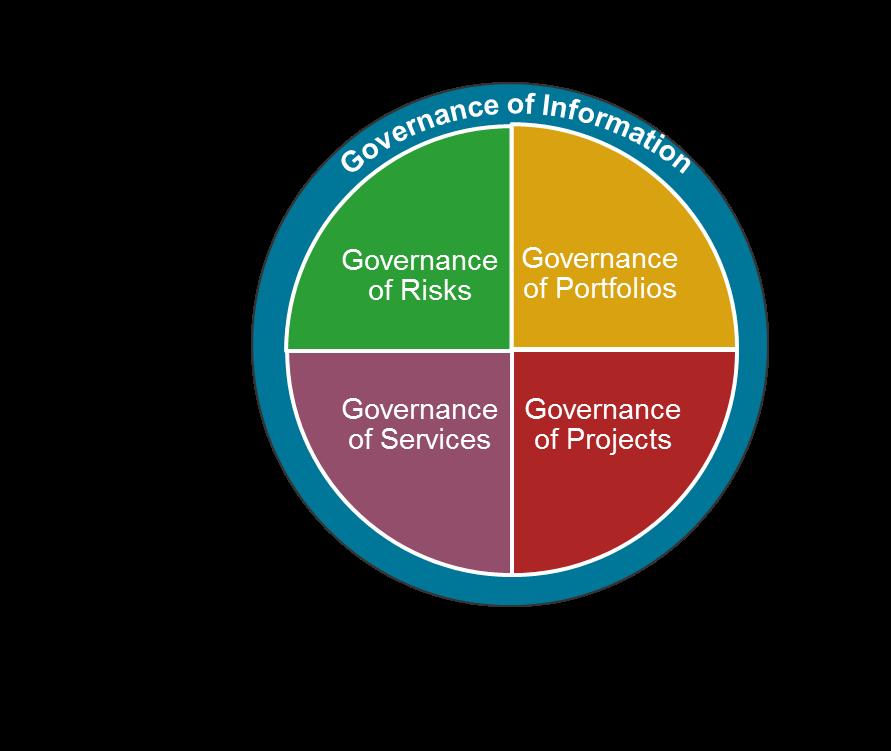
Governance of Information: ensures the appropriate classification and retention of data, based on business need.
By leveraging the division of governance that account for most key IT decision-making, City management can better understand their role in governance, fostering ownership and joint accountability.


A survey of City Stakeholders identified the governance of projects and portfolio/investment as their two biggest priorities
Which areas of IT governance impact In which IT governance area would you most like to see improvement?
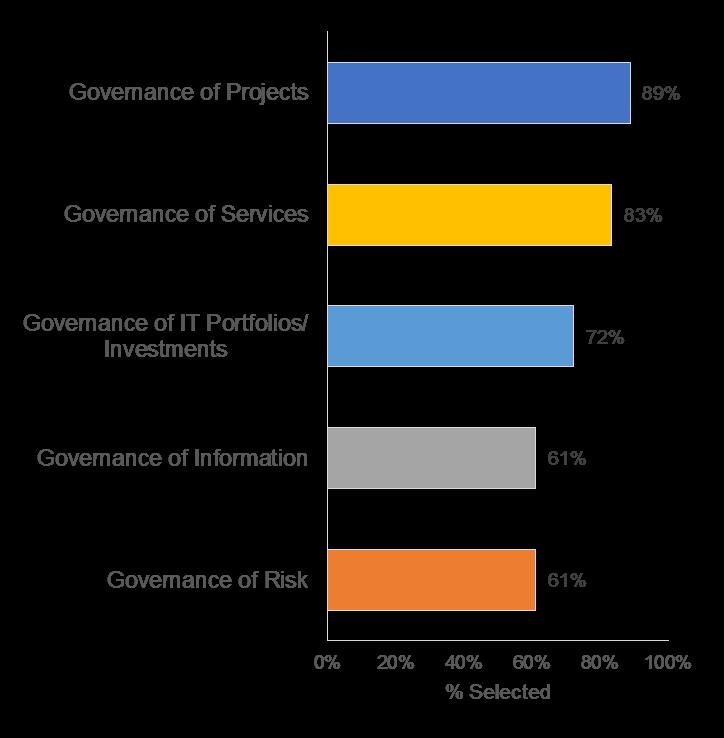
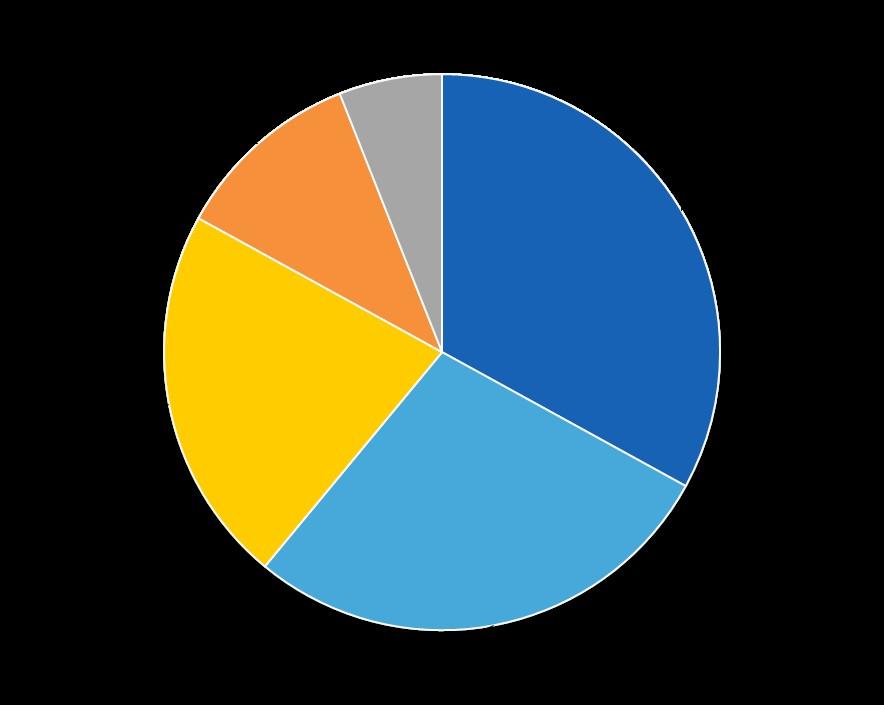



Proposed Success Metrics for Portfolio & Project
Governance

Portfolio

•% of projects completed (vs. approved)
•% of projects that went through formalized approval process (vs. ad hoc)
•% Department Utilization of Platform Solutions
•% of systems in support with redundant capabilities
•% of IT staff hours allocated to high priority projects
•% of staff hours allocated to portfolio management

Project

• % of projects completed on time
• ROI from project ($)
• Efficiency tracking
• Planned vs. actual resources (FTE)
• % of project milestones met
• Forecasted value vs. actual value
• Number of existing project dependencies impacting the new project
• ROI of training ($)


IT Governance Committee Structure
After completing the current and target state analysis the group identified the need for an IT Steering Committee and an IT Governance Team located in the Office of the CIO
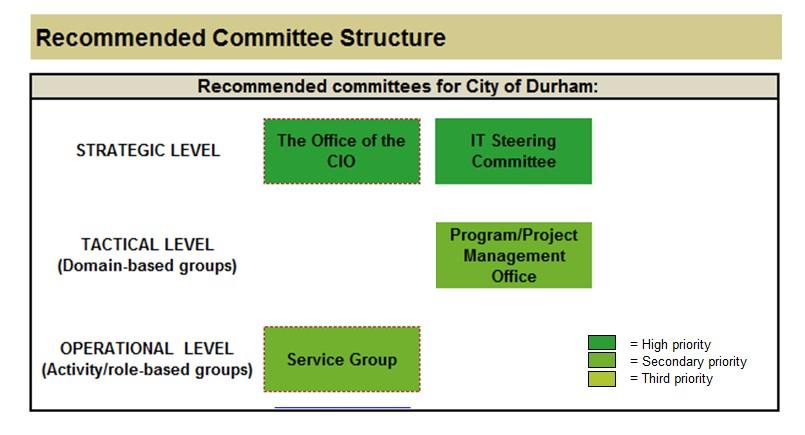




IT Steering Committee
IT STEERING COMMITTEE PURPOSE
STATEMENT:
The IT Steering Committee is responsible for the alignment of IT standards and projects to the City of Durham’s Strategic Plan.
To this end, the IT Steering Committee is tasked with reviewing, prioritizing, and approving major IT portfolio projects, as well as the assessment of project success and the overall value Technology Solutions provides the City of Durham.
IT STEERING COMMITTEE RESPONSIBILITIES
• Making City-Wide IT Project Prioritization & Budget Recommendations
• Approving City-Wide IT Standards (Supported Technology)
• Recommendation of a Target Investment Mix & Strategically Prioritizing Resource Allocation
IT STEERING COMMITTEE MEMBERS
Deputy City Manager
Deputy City Manager
Deputy City Manager
CIO
Budget Director
Finance Director
• Selecting, Approving & Evaluating (Scheduled & Unscheduled) Projects within defined threshold
• Approving the Process for Determining IT Value
• Identifying Process for Reviewing Obstacles to Project Completion
• Approving Optimization Plans for IT Governance Structure/Process
COMMITTEE MEETING
CADENCE
The IT Steering Committee will meet once a quarter with a focused agenda tailored to its members. Departments will be invited to make presentations on agenda items for approval


IT Steering Committee Participant RACI analysis
It is not enough to participate in committee meetings; there needs to be a clear understanding of who is accountable, responsible, consulted, and informed about matters brought to the attention of the committee.
An authority matrix is often used within organizations to indicate roles and responsibilities in relation to processes and activities.
Using the RACI model as an example, there is only one person accountable for an activity, although several people may be responsible for executing parts of the activity.
In this model, accountable means end-toend accountability for the process. Accountability should remain with the same person for all activities of a process.
R Responsible
Responsible for getting the job done
A Accountable
Accountable for each task (only one person can be accountable)
C Consulted
Involved through input of knowledge and information
I Informed
Receives information about process execution and quality


Prioritized Responsibilities and Accountabilities of


IT Governance Model Roles and Responsibilities
Business Units Role
• All Departments/business units will submit all IT projects for approval and prioritization prior to implementation
• After approval if new resources are required, the request will be forwarded to the BMS Budget development process as new budget initiatives
TS Project Management Office Role
• Assist business units with IT project business case preparation for governance committees’ review
• Determine resource requirements for projects
• Manage approved projects
• Prepare Project Management Office performance metrics


IT Governance Model Roles and Responsibilities
Office of CIO
• Prepare agenda for Governance Steering Committee
• Review all projects prior to submission to Governance Steering Committee with recommendations for project priority and schedule
• Develop a Citywide Enterprise IT Strategic Plan for steering committee review and approval
• Propose enterprise IT standards for approval by steering committee IT Steering Committee
• Approve and prioritize all IT projects for the City
• Approve Citywide Enterprise IT Strategic Plan
• Approve City IT standards such as security standards

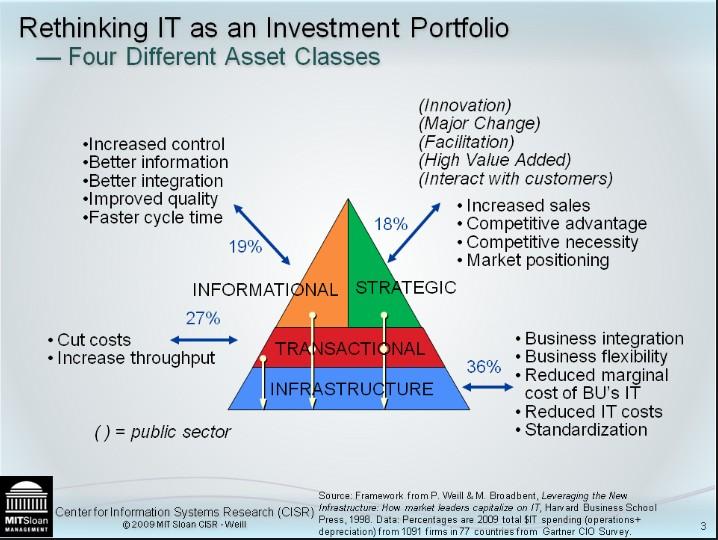

– Where Great Things Happen

Overview of IT Governance Workflow
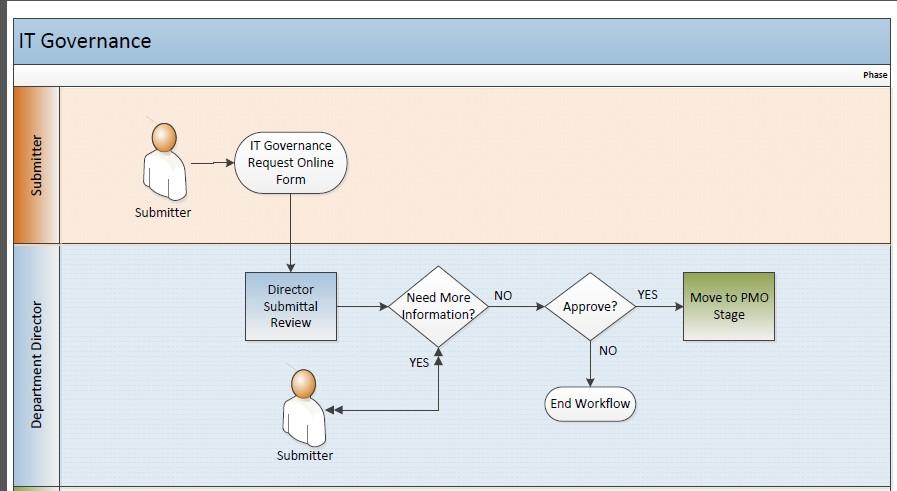


Overview of IT Governance Workflow
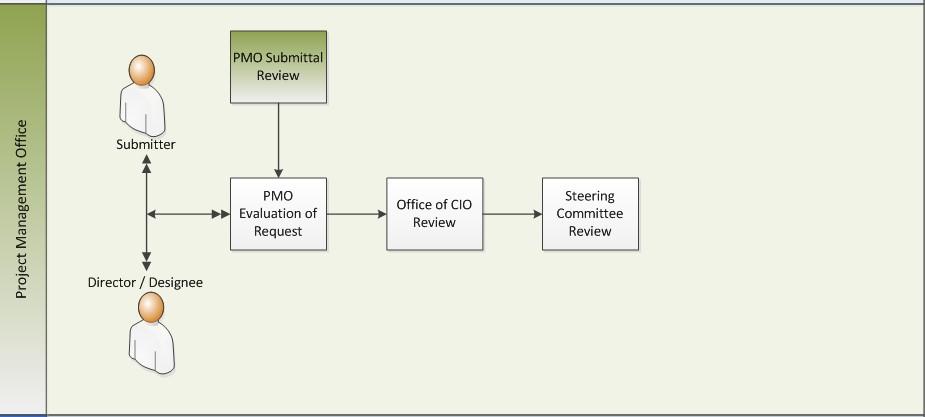

IT Steering Committee Responsibility SIPOC
1. Making City-Wide IT Project Prioritization and Budget Recommendations
Project Owner through the CIO Committee
Business case proposal (go through CIO Committee)
Cost forecasting and analysis for all project requests
Evaluate projects business cases from each department based on the City’s Strategic Plan
Evaluate the technology fund alignment to projects need Approval
Reject with justification
Prioritization of projects
Forward with recommendation to obtain funding
2. Approving City-Wide IT Standards
TS Management through the CIO Committee Benchmarking data from other organizations Value proposition (costs, ROI, etc.)
Best practices and industry standards in aligning software, hardware to solving City business problems
Recommended standards for adoption
Evaluate the
standard and approve or deny proposals


IT Steering Committee Responsibility
3. Recommends the Target Investment Mix & Strategically Prioritizing Resource Allocation Citywide Enterprise IT Strategic Plan Management
Citywide Enterprise IT Strategic Plan
Approve the target investment mix and strategically prioritize resource allocation
Prioritize initiatives that are best aligned with the City’s strategic plan
Approved multi-year Citywide Enterprise IT Strategic Plan
Mechanism for rejecting, postponing and re-evaluating strategic project proposals


CIO Committee
CIO COMMITTEE PURPOSE STATEMENT:
The CIO Committee provides strategic direction to the City of Durham’s IT Steering Committee and business units regarding IT operations and project planning. It also provides oversight around project feasibility and resource allocation for IT Steering Committee decisions and initiatives.
CIO COMMITTEE GOVERNANCE RESPONSIBILITIES
• Creating Standards & Policies for Resource Management
• Reviewing PPM, PM & Project Metrics
• Determining the Cadence for Project Launches
• Reviewing Project Proposals prior to Steering Committee approval
• Assessing Ongoing Project Risk
• Propose alternative solutions for Steering Committee approval (for high risk/investment projects)
• Propose IT Standards for Steering Committee review
CIO COMMITTEE MEMBERS
Committee Members:
CIO
IT Project Manager
Assistant Director
CSM Manager
COMMITTEE MEETING
CADENCE
The CIO Committee will convene a Governance meeting once per month



High-level communication plan
What is Changing?
In support of its strategic goal – to become an Innovative & High Performing Organization, the City of Durham is moving towards a structured, process oriented governance model. The first stage of establishing an IT Governance model for the city is the creation of an IT Steering Committee tasked with making high-level IT decisions, and establishing the City’s technology priorities.
Why is it Changing?
The City of Durham is making this change to improve IT Portfolio Governance and IT Project Governance. These governance areas were identified by stakeholders throughout the organization as the top priorities for optimization.
When is it Changing?
The roll out of the new governance structure and processes will begin with a pilot phase commencing in July 2016. Prior to this, TS will be refining its project lifecycle processes and will be meeting with key stakeholders throughout the organization to review the changes and opportunities. Upon the completion of a successful pilot, the full implementation is scheduled for the FY2018 budget cycle.
Who will be communicating the change?
The plan will be communicated by the PMO in collaboration with the PA Office.


Action Plan for March 7 – Oct 1
